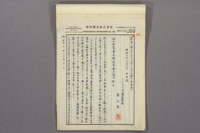Establishment of Emigration and Settlement Companies
Formation of the "Burajiru Imin Kumiai" (Brazil Emigration Cooperative) and the resumption of emigration
Emigration to Brazil was discontinued in 1914 because the São Paulo State Government ceased a grant for a voyage. In March 1916, the Toyo Imin Gaisha (Toyo Emigration Company), the Nanbei Shokumin Kaisha (South America Colonization Company) and the Morioka Imin Kaisha (Morioka Emigration Company) formed the Brazil Imin Kumiai (Brazil Emigration Coopeative) and Tadao Kamiya of the Toyo Imin Gaisha (Toyo Emigration Company) was dispatched to the State of São Paulo to negotiate for the resumption of emigration. Taking advantage of a situation where immigration from Europe had been interrupted due to World War I, on August 14 of that year, Kamiya successfully concluded an agreement with the Antunes dos Santos Company which the State Government had granted a privilege to attract immigrants. The agreement obliged the cooperative to ship 4 to 5 thousand emigrants every year provided that the State Government provides travel grants for immigrants. Emigration again resumed in 1917 upon the agreement.
Establishment of the Kaigai Kogyo Kabushiki Gaisha (Overseas Enterprise Company Limited)
Meanwhile, in July of 1917 in Japan, the Terauchi Cabinet submitted an amendment to the "Toyo Takushoku Kabushiki Gaisha Ho" (Oriental Colonization Company Limited Act) which allowed the statutory corporation the Toyo Takushoku Kabushiki Gaisha (Oriental Colonization Company Limited) to acquire stocks and debt securities of emigration companies in order to resolve the situation where many small cap emigration companies pointlessly competed with each other and also to promote the development and growth of emigration large capital projects as one of Government policies.
On December 1, 1918, under the mediation of Minister for Finance Kazue Shoda, the emigration businesses of the four companies, Toyo Imin Gaisha (Toyo Emigration Company), Nanbei Shokumin Kaisha (South America Colonization Company), Nippon Shokumin Kaisha (Japan Colonization Company) and Nitto Shokumin Kaisha (Nitto Colonization Company) were merged and the Kaigai Kogyo Kabushiki Gaisha (Overseas Enterprise Company Limited) (Abbreviated "Kaiko") was established.
In April of 1919 the company merged with the Brazil Colonization Company and took over the management of the Iguape Colony, then in November of 1920, acquired the sole remaining company, the Morioka Imin Gaisha (Morioka Emigration Company). As a result Kaigai Kogyo Kabushiki Gaisha (Overseas Enterprise Company Limited) became the only Japanese emigration company as well as the colonization company managing colonies.
In 1921, the Social Welfare Bureau, Home Ministry began supplying the Kaigai Kogyo Kabushiki Gaisha (Overseas Enterprise Company Limited) with a grant of 100 thousand yen to encourage emigration and settlement, and the company distributed printed materials and held film tours and exhibitions of agricultural products all over the country to raise awareness of emigration. The number of applicants for emigration, however, fell due to the favorable economic conditions after World War I and the company was able to collect only a portion of all the voyage expenses it had loaned to emigrants, so the company was continuously in financial difficulties until mass emigration began with Government travel grants for the entire voyage expenses in 1924.
-
Articles in newspapers / magazines
-
Books
-
 Outline of the Kaigai Kogyo Kabushiki Gaisha (Overseas Enterprise Company Limited)
Outline of the Kaigai Kogyo Kabushiki Gaisha (Overseas Enterprise Company Limited)
-
 Kaigai Kogyo Kabushiki Gaisha (Overseas Enterprise Company Limited) Brazil office that should take care of immigrants as their parents took care of their children
Kaigai Kogyo Kabushiki Gaisha (Overseas Enterprise Company Limited) Brazil office that should take care of immigrants as their parents took care of their children -
 Pick up potatoes competition in the Indian Ocean Great Athletic Meeting (On board the ship Shiatoru-maru) (June 13, 1917)
Pick up potatoes competition in the Indian Ocean Great Athletic Meeting (On board the ship Shiatoru-maru) (June 13, 1917) -
 Report on supervision of emigrant transportation
Report on supervision of emigrant transportation
Assimilation incentives and anti-Japanese legislation
Policy of the Japanese Embassy and consulates in Brazil
According to the increase in the number of Japanese residents, Japanese consulates were established in São Paulo in 1915 and Bauru, which was the starting point of the Noroeste line in the northwest part of the State of São Paulo, in 1921. Until diplomatic relations between Brazil and Japan were severed due to the outbreak of the Pacific War, the majority of the Japanese population in Brazil still maintained Japanese citizenship and had much closer ties to these overseas representatives of the Japanese Government than with the Brazilian Government, and remained under the guidance and control of these consulates.
When the ship Kasato-maru arrived, the newspapers in São Paulo featured articles praising the Japanese immigrants; the newspapers of the capital of Rio de Janeiro, however, featured articles critical of the reception of Japanese immigrants in the country, claiming that the immigrants were averse to assimilation and formed quisto (a term meaning groupings of foreign elements, in this case Japanese immigrants, inside Brazilian communities).
Learning the lessons of the failures faced in the United States in the past, the Japanese Embassy and consulates in Brazil paid careful attention to any anti-Japanese movements in Brazil and attempted to proactively prevent any escalation of such movements. Measures to achieve this included cautioning Japanese immigrants to avoid any friction with the Brazilian communities and encouraging the immigrants to assimilate.
In consideration of the fact that Brazil was a Catholic nation, travel to Brazil by any non-Catholic missionaries was also severely restricted and the Japanese Embassy and Consulates also occasionally reminded Japanese immigrants to be mindful and careful of their manners and how they comported themselves in public.
Bill on the restriction of Japanese immigration – the Reis bill
Despite the care that Japanese diplomats had exercised, on October 22, 1923, influenced by the complete ban imposed on Japanese immigration in the United States, congressman Fidélis Reis, ( from the State of Minas Gerais) introduced a bill to prohibit the entry of "black-skinned" immigrants and restrict the number of "yellow-skinned" immigrants below 3% of the total current population of "yellow races" already in the country (revised below 5% in December by the Agriculture and Industry Committee). The introduction of the bill elicited many excited discussions on the pros and cons of restricting Japanese immigration in Portuguese language Brazilian newspapers. The Japanese Embassy lobbied the Congress to drop the bill; the bill, however, continued to be referred to both the Agriculture and Industry Committee and the Finance Committee until 1927.
-
Articles in newspapers / magazines
Precautions from the Japanese Consul General at São Paulo to Japanese immigrants
-
 Consulate General of the Empire of Japan located in Rua Brigadeiro Luis Antonio, São Paulo and responsible for the safety of the people of Japan
Consulate General of the Empire of Japan located in Rua Brigadeiro Luis Antonio, São Paulo and responsible for the safety of the people of Japan -
Articles in newspapers / magazines
Precautions on manners in public (article published in a Japanese language newspaper)
-
 Interior of "Kunii Shoten" (Kunii Store)
Interior of "Kunii Shoten" (Kunii Store) -
Articles in newspapers / magazines
-
 Dressed up Japanese immigrant family listening to a phonograph
Dressed up Japanese immigrant family listening to a phonograph














